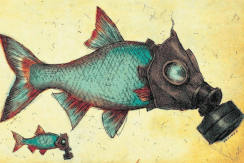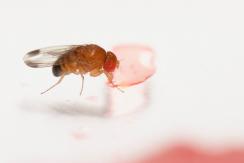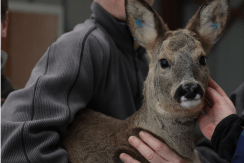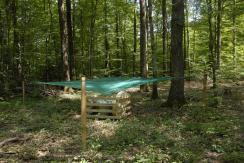Evolutionary Ecology
The department of Evolutionary Ecology gathers complementary skills in behavioural ecology, population dynamics, population biology, community ecology, and methodology (statistics and modelling). The research done in the department aims at studying how animal species evolve in a changing world by understanding the causes of the evolution of traits, adaptations and interactions. For that, we consider different levels of organization from individuals to populations and communities. Because organisms cannot be considered isolated from other biotic factors, we consider pathogens but also competing species within communities.
We study how individuals adapt to their environments that are largely impacted by anthropic pressures, and how life history traits and behaviour evolve in response to these pressures. Although we mainly focus on phenotype, we more and more consider the mechanistic link between the genotype and the phenotype. We develop the theoretical framework of our discipline through a conceptual and modeling approach. In parallel, we test hypotheses that arise from theoretical predictions through experimental, comparative and observational approaches on different biological models (insects, birds, mammals). Experimental approaches are developed in the laboratory (insect model) and in natura (bird, insect and mammal models). Observational and comparative research is mainly concerned with vertebrates. Our approaches are also, and increasingly, interested in the mechanisms of adaptive responses. In addition to the classical approaches of demographic analysis and trait change, methods of ecophysiology, chemical ecology and molecular biology are used.
Our department hosts several long-term studies of wild populations of different species. These long-term studies offer a valuable way to understand how biotic and abiotic factors affect individuals’ life history traits, and the functioning of populations in natura. Five populations of mammalian species are thus monitored for several years (more than 40 years on roe deer, 30 on Alpine marmots, 25 years on cats, 16 years on zebras, and 20 years on impala). Two of our study sites (La Sassière in Vanoise National Park (Alpine marmots) and Hwange National Park) have been certified as “Site d’Etude en Ecologie Globale” (SEEG), and two (ZA “Hwange” and ZA “Antarctic and sub-Antarctic”) were certified as “Zone Atelier” by the CNRS.
The department of Evolutionary ecology is also largely involved in training activities. Lastly, we also have strong socio-economic relationships. Indeed, because we address questions of major societal interest (global warming, public health) we tightly collaborate with socio-economic partners (Office Français de la Biodiversité, Vanoise National Park, Hwange National Park in Zimbabwe, Office National des Forêts, etc.) and participate to general public and media events.
Publications
Display of 2341 to 2370 publications on 2449 in total
At-risk individuals in Feline Immunodeficiency Virus epidemiology: Evidence from a multivariate approach in a natural population of domestic cats (Felis catus)
Epidemiology and Infection . 121 ( 1 ) : 227-236
Journal article
see the publicationRelation between the generation time and the lag time of bacterial growth kinetics
International Journal of Food Microbiology . 43 : 97-104
Journal article
see the publicationOviposition pattern of phytophagous insects: on the importance of host population heterogeneity.
Oecologia . 114 : 382-388
Journal article
see the publicationDynamics of a feline retrovirus (FeLV) in host populations with variable spatial structure
Proceedings of the Royal Society B: Biological Sciences . 265 : 1097-1104
Journal article
see the publicationDesiccation and starvation tolerance of adults Drosophila : opposite latitudinal clines in natural populations of three different species
Evolution - International Journal of Organic Evolution . 52 : 825-831
Journal article
see the publicationPopulation Dynamics Modelling in an Hierarchical Arborescent River Network: An Attempt with Salmo trutta
Acta Biotheoretica . 46 : 223-234
Journal article
see the publicationA density dependent model describing Salmo trutta population dynamics in an arborescent river network. Effects of dams and channelling
Comptes rendus de l’Académie des sciences. Série III, Sciences de la vie . 321 : 979-990
Journal article
see the publicationSelection of fruits for oviposition by the chestnut weevil Curculio elephas
Entomologia Experimentalis et Applicata . 86 : 71-78
Journal article
see the publicationEpidemiology of feline leukemia virus (FeLV) and structure of domestic cat populations
Journal of Wildlife Management . 62 : 978-988
Journal article
see the publicationRetroviruses and sexual size dimorphism in domestic cats (Felis catus L.)
Proceedings of the Royal Society B: Biological Sciences . 265 : 167-173
Journal article
see the publicationLight body pigmentation in Indian D. melanogaster : a likely adaptation to a hot and arid climate
Journal of Genetics . 77 : 13-20
Journal article
see the publicationDescribing the evolution of reaction norm shape : body pigmentation in Drosophila
Evolution - International Journal of Organic Evolution . 52 : 1501-1506
Journal article
see the publicationPhenotypic plasticity of body pigmentation in Drosophila : correlated variations between segments
Genetics Selection Evolution . 30 : 181-194
Journal article
see the publicationPhenotypic plasticity and developmental temperature in Drosophila : analysis and significance of reaction norms of morphometrical traits
Journal of Thermal Biology . 22 : 441-451
Journal article
see the publicationGenetic variability of quantitative traits in Drosophila melanogaster (fruit fly) natural populations: analysis of wild-living flies and of several laboratory generations
Heredity . 80 : 326-335
Journal article
see the publicationCold stress tolerance in Drosophila : analysis of chill coma recovery in D. melanogaster
Journal of Thermal Biology . 5 : 291-299
Journal article
see the publicationIdentification of soil factors that relate to the structure of the plant parasitic nematode community
Applied Soil Ecology . 8 : 35-49
Journal article
see the publicationEcology of larval mosquitoes with special reference to Anopheles arabiensis (Diptera: Culcidae) in market-garden wells in urban Dakar Senegal
Journal of Medical Entomology . 35 : 948-955
Journal article
see the publicationADE-4 Software: a tool for multivariate analysis and graphical display
Océanis : Série de documents océanographiques . 24 ( 4 ) : 393-416
Book chapter
see the publicationStratégies de ponte et traits d`histoire de vie chez les insectes
incollection . -- : 445-450
Journal article
see the publicationInfluence of genomic G+C content on average amino-acid composition of proteins from 59 bacterial species
Gene . 205 : 309-316
Journal article
see the publicationRelationships between genomic G+C content RNA secondary structures and optimal growth temperature in prokaryotes
Journal of Molecular Evolution . 44 : 632-636
Journal article
see the publicationEffect of temperature and photoperiod on diapause development in a Douglas fir seed chalcid Megastigmus spermotrophus
Oecologia . 111 : 172-177
Journal article
see the publicationEffect of temperature and photoperiod on diapause development in a Douglas fir seed chalcid, Megastigmus spermotrophus
Oecologia . ( 111 ) : 172-177
Journal article
see the publicationModelling the feline leukemia virus (FeLV) in natural populations of cats (Felis catus)
Theoretical Population Biology . 52 : 60-70
Journal article
see the publicationInfection strategies of retroviruses and social grouping of domestic cats
Canadian Journal of Zoology . 75 : 1994-2002
Journal article
see the publicationCharacterization of two distinct species of Arvicanthis (Rodentia: Muridae) in West Africa: cytogenetic, molecular and reproductive evidence
Journal of Zoology . 241 ( 4 ) : 709-723
Journal article
see the publicationDNA–DNA Hybridization Evidence for the Recent Origin of Marmots and Ground Squirrels (Rodentia: Sciuridae)
Journal of Mammalian Evolution . 4 ( 4 ) : 271-284
Journal article
see the publicationBalanced dispersal between spatially varying local populations: an alternative to the source-sink model
The American Naturalist . 150 : 425-445
Journal article
see the publicationAnalyse comparative de la transmission de cinq virus dans des populations de chats domestiques (Felis catus L.)
incollection . -- : 1143-1148
Journal article
see the publication





You also, comment on this article